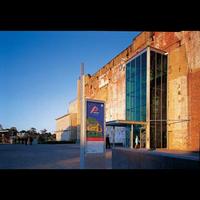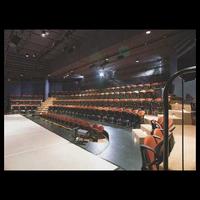Luckily the topic for this month’s grid blogging exercise is ‘ritual’ – it fits into what I?ve been thinking and writing about for the last couple of years – my masters thesis is a study of Brisbane?s contemporary chamber music scene as a subculture. A fundamental principle behind what I?ve been doing is that music can?t be defined as an object, a thing, or even ?organised sound?. Instead, we have to think of “music” as a verb, as a field of social action or interaction. As Christopher Small so succinctly puts it, “music is not a thing at all”, but “something people do”.
The most obvious place to look for music as social action of course is in performance, where certain social identities, sounds, spaces and temporal relationships work together to create and recreate the relationships (between people, between past and present, between sounds, between bodies and space) that seem ?right? to the participants, thereby affirming a shared sense of belonging and cultural value:
What is going on in this concert hall is essentially the same as that which goes on during any musical performance. Members of a certain social group at a particular point in its history are using sounds that have been brought into certain kinds of relationships with one another as the focus for a ceremony in which the values?which is to say, the concepts of what constitute right relationships?of that group are explored, affirmed, and celebrated. […] During a musical performance, any musical performance anywhere and at any time, desired relationships are brought into virtual existence so that those taking part are enabled to experience them as if they really did exist. (Small, Musicking p. 183)
Therefore, any musical performance can be understood as a ritual. Here?s an impressionistic description of what I see as the ritualistic aspects of a contemporary chamber music concert. The example I use is from my case study of Topology and their audiences participating in a concert at the Brisbane Powerhouse. I feel no shame in importing a chunk of my thesis considering the impending deadline I’m under – but I do feel I should give a Clunky Academic Prose Warning.
[begin thesis chunk import]:
On a Friday or Saturday night, after driving through the club, bar, and restaurant strip of Fortitude Valley, which is just starting to come alive for the night, the members of the audience drive past new boutique apartment complexes and the now-empty New Farm Park, before approaching the Brisbane Powerhouse. The members of the audience might be dressed in whatever they had on that day, in styles ranging from neo-bohemian casual attire to contemporary streetwear, or they may have dressed for the occasion in the uniform of contemporary art music – black trousers and turtleneck jumper. Those less familiar with contemporary art music and who are more used to attending classical concerts at the Queensland Performing Arts Centre might have come in ?smart casual? as for a special evening out, but formal jackets and ties or evening wear would be almost laughably out of place and would mark the wearer as aspirational, suburban, or middlebrow.

The audience approaches the Powerhouse either via the well-lit walkway, flanked on either side by now-darkened New Farm Park, or up the staircase from the open-air car park to the large flat piazza area. Surrounded by darkness and backing onto the river, the Powerhouse gives the appearance of monolithic size. On passing through the tall glass entry doors, the immediate impression is one of vertical space. Once inside, the audience is free to wander at will around the open space of the Powerhouse, passing the doors to its various concert spaces and usually walking straight through to the Spark Bar with its colourful couches, central bar area and its windows facing out to the river, which is dark and quiet apart from the occasional dinner cruise boat going past. It is hard to distinguish the Topology audience from the patrons of other, bigger, Powerhouse events, except perhaps that they are quieter, travel in smaller groups (or even alone), and seem to move with a quiet, unassuming confidence around the open labyrinth that is the Powerhouse?s interior. They might leaf through the piles of leaflets, street newspapers, and advertisements for upcoming events in the foyer, or they may peruse the art or photography works exhibited along the lengths of the interior walls, drink in hand.
As the beginning of the concert draws near, they walk quietly and confidently through the door in groups of two or three, sweeping up a photocopied program from the table outside and showing the usher their tickets on the way through without being asked to do so. They take their seats, settle in, and gaze around the room at the other audience members, read the program notes, chat quietly, or wave to acquaintances from across the room, sometimes even taking the opportunity to wander over to the other side for a quick chat before performance time. The atmosphere is relaxed and sociable, but expectant.

As the performers emerge from the black curtain that serves to separate the performance area from the backstage area of the room, there is a noticeable shift of social focus from the communal audience to the stage. The performers smile and perhaps wave to friends as they take to the stage, and a warm round of applause greets them. The members of Topology smile in the general direction of the audience, then exchange glances of readiness between them, and perhaps perform a quick intonation check before the symbolic leader, bassist and composer Robert Davidson turns to address the audience. He will usually share an anecdote about the pieces on the program, or sometimes an in-joke about a local composer. As the performers lift their arms and ready their instruments, the lights dim and at the same time a hush falls over the crowd, creating the illusion of suspended time, and of separated sonic space from which the music will emerge. The bodies of the audience members are stilled and the visual environment is as unobtrusive as possible so that each individual member can experience the full impact (whether that impact is experienced as physical, emotional, or intellectual) of their engagement with the music.
Audience behaviour at a ?classical? concert can seem passive, meek, and empty of social meaning (as compared with the rave or the mosh pit at an indie rock gig) but it can be more productively interpreted as a meaningfully structured form of social action that requires prior knowledge on behalf of the audience members. The audience reproduces a familiar repertoire, based directly on established ?interactive competencies? with which they negotiate the material and cultural space of the concert. The cultural competencies required in this case include the ability to ?correctly? read the layout of the concert space, correctly interpreting the flow of the concert (clapping at the appropriate point in the performance), knowing when to laugh, when to enter, when to leave, when to move to the music, when to be silent, when to speak, to whom, and at what volume. These behaviours ? gestures, styles of deportment, and other communicative or goal-directed actions like finding a seat, applauding and chatting ? dynamically reinforce and are reinforced by the performances of the musicians on stage, establishing the audience and musicians as competent in the performance of the concert ritual, and creating a naturalized sense of belonging. [end thesis chunk import]
More [grid::ritual] posts here
4 responses to “[grid::ritual] Sounds in Social Space: The Contemporary Chamber Music Concert”
Very nice! Can’t wait to read the whole thesis 🙂
thanks anne – I’m sure you’ll appreciate how nice it is to hear positive feedback when I’m teetering on the brink of submission – two days to go!!
Go get ’em Jean!
Hi Jean – great blog. I think looking at concerts as rituals is a very revealing study.